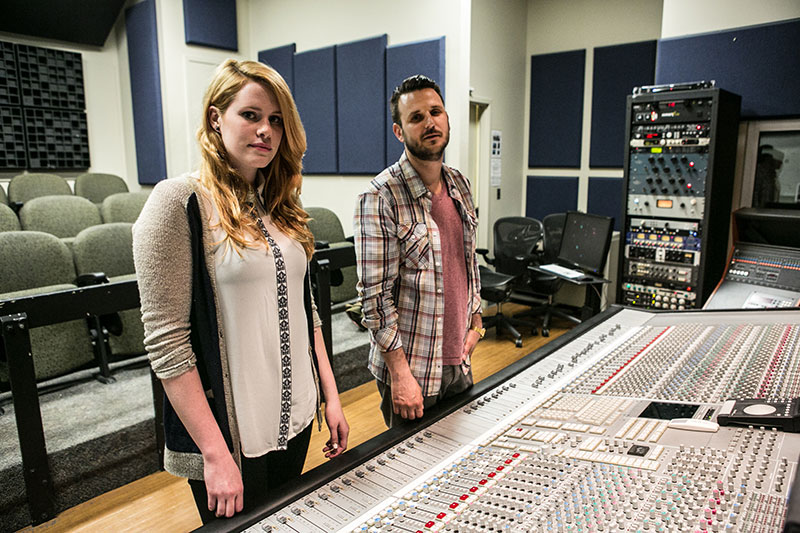Not every music-obsessed college junior gets to run a record label. Fortunately for Michael Rodino, he enrolled in one the nation’s preeminent music industry-focused academic programs. As a music industry major at Drexel’s Westphal College of Media Arts & Design, the 21-year-old junior has the unique opportunity of working for MAD Dragon Records, a fully functional independent label that recently celebrated a decade of existence.
“My job is just to make sure that everything stays organized,” says Rodino, who has been serving as MAD Dragon’s label manager for the past eight months. Together with faculty advisor Terry Tompkins, Rodino oversees a staff of 15, who are responsible for finding talent, booking shows, managing artists, reaching out to the press, planning new releases and much, much more.
Dozens of schools offer music industry programs, but very few run a record label of MAD Dragon’s caliber. The label has won several Independent Music Awards and was named by Rolling Stone as “one of the most inventive music programs around.” Over the years, MAD Dragon has helped launch the careers of Philadelphia-based artists like Hoots & Hellmouth and has worked with notable acts such as Motion City Soundtrack and The Redwalls, which signed with MAD Dragon after the band’s contract with Capitol Records ended.
Participation in the label’s operation is a requirement for all of the school’s business-focused music industry majors. Every student takes the MAD Dragon capstone course for a required two semesters. Many of them wind up staying involved with MAD Dragon beyond that, eagerly sopping up the uniquely comprehensive real-world experience the label provides. Unlike off-campus internships, MAD Dragon lets students get their hands dirty in various aspects of the business instead of just one.
“There isn’t anything that they can’t get their hands on,” says Tompkins, who has been overseeing MAD Dragon for nine years.
“Everything is accessible. You go on your internship and the company might be more guarded about the type of work you can do. Here, we want to provide a platform for students to be able to fail and learn from their mistakes.”
Twice a week, the class meets not in a lecture hall but in a conference room at the label’s headquarters. For the students, it feels less like another course and more like a morning team meeting at a subdivision of EMI Records or any other major label. In these hour-and-a-half-long sessions, students report their progress on whatever project or artist they’ve taken on for the semester and work with Tompkins, Rodino and other managers to determine where to focus their energy next.
“It’s really a self-determined class,” Rodino says. “Everyone is expected to run themselves. We want them to be in direct contact with the artists and with everyone they need to be, whether they need to order merchandise, order CDs or whatever it is.”
In mid-May, MAD Dragon celebrated its 10th anniversary by hosting a concert at the Trocadero featuring a genre-spanning array of artists who have worked with the label over the years, including Philly’s beloved psychedelic pop rock outfit Cheers Elephant. Planning the show was a months-long effort divided among several students.
Haley Holmes, a 2013 graduate of Westphal’s music industry program, was one of those staffers. Leading up to the show, Holmes was heavily involved in courting press coverage, ultimately scoring publicity from NPR, Fox, NBC and a host of local music blogs and publications. In her first stint at MAD Dragon during her freshman year, Holmes was responsible for putting together Unleashed, the label’s annual compilation CD. This included everything from sending and receiving artist contracts to art-directing the album cover and scheduling the studio mastering sessions. It was a large, multi-faceted project, but it’s emblematic of the variety of work students get to do with MAD Dragon.
MAD Dragon has released 32 titles from 17 artists and received 35 nominations from the Independent Music Awards.
“To be able to do all of that as a freshman was a truly invaluable experience,” says Holmes, who was 18 years old when she first started working with MAD Dragon. “Plus, it was amazing to have my name in the album credits more than five times.”
For 10 years, MAD Dragon has shaped the budding careers of more than 280 graduates from the program. In that time, it has released 32 titles from 17 artists and received 35 nominations from the Independent Music Awards. In 2004, the label signed its first artist, Jules Shear, a singer-songwriter who is credited with launching MTV’s famous Unplugged series. Two years later, Shear was profiled by the New York Times, coverage that played a role in propelling MAD Dragon toward a type of legitimacy not typically enjoyed by university-based record labels.
Crucial seed money to launch MAD Dragon Records came from long-time University benefactor Dr. Marcia Robbins-Wilf. In 2002, then Westphal College Dean Jonathan Estrin approached her about supporting a new direction for music in the college, and she quickly responded with a generous gift. A recording studio was named in her honor.
MAD Dragon Records is also supported by the Kal & Lucille Rudman Institute for Entertainment Industry Studies. Ten years ago Kal Rudman, a longtime legend in the music business and founder of one of the most important trade journals in the industry, The Friday Morning Quarterback, along with his wife Lucille, made a generous gift to the Westphal College, creating the Kal & Lucille Rudman Institute for Entertainment Industry Studies which supports MAD Dragon Records.
As important as new talent and press coverage are, they weren’t enough.
To truly be taken seriously by artists and peers, MAD Dragon needed something more. That something came in 2005 when the label inked a distribution deal with Rykodisc Records, a successful independent record label that was later acquired by Warner Music Group and folded into the Alternative Distribution Alliance. Suddenly, this scrappy college label based in West Philadelphia had major label distribution.
It was this widespread reach into online music retailers that made MAD Dragon an attractive destination for up-and-coming artists. Indeed, it was the centerpiece of the pitch made to The Redwalls, an Illinois-based indie rock duo that signed with MAD Dragon in 2007. Around the same time, MAD Dragon was named the College Label of the Year by the Independent Music Awards, which doled out the distinction to MAD Dragon once more in 2008.
“When we launched the label, we were literally doing consignment deals with record stores in the Philadelphia area,” Tompkins says. “When we got a distribution deal, it became really important for artists to look at us seriously as a player in the marketplace, because we were partnering with Warner Music and had the resources to distribute the records all over the country and all over the world.”
The label’s newfound prestige also grabbed the attention of Hoots & Hellmouth, a Philadelphia-based Americana band that released its first album on MAD Dragon in 2007. The band received laudable national press and enjoyed success as a touring band before releasing its 2009 follow-up, The Holy Open Secret.
Over the course of two MAD Dragon-released records, Hoots & Hellmouth had amassed quite a following. At the same time, the industry was evolving and along with it changed the role of labels like MAD Dragon. In late 2010, Hoots & Hellmouth decided it didn’t need a label at all. The band turned to the crowd-funding site Kickstarter and launched a campaign to fund the release of a six-song EP. The response was overwhelming. Ten thousand dollars later, the band decided to aim for the production of a full-length LP and asked for a grand total of $15,000. By the time the campaign ended, the band had amassed more than $23,000 in contributions from fans and landed in Kickstarter’s own hall of fame.
MAD Dragon could not have launched at a more transformative moment in the industry’s history.
When the label started in 2003, Apple had just unveiled iTunes, the first viable online music marketplace to emerge from the post-Napster chaos of the early 2000s. Four years into being ravaged by peer-to-peer filesharing, the industry finally found hope for monetizing digital music, but by then the Internet had irreversibly handicapped the model upon which the major labels had long relied. Between 1999 and 2009, overall revenue from the sale of recorded music in the United States declined by 57 percent, according to Forrester Research. In 2011, digital music sales would see their first year-over-year increase and physical formats continued to slowly fall out of favor with consumers.
That same year, the all-you-can-stream music subscription model got a major boost when Spotify launched in the United States. In 2013, these streaming services are proliferating, with Google having launched its own Spotify competitor in May and at least two more players expected to launch before the end of the year. These services might be growing in both number and usage, but the economics behind them are even murkier than the digital download model that was born a decade ago.
For record labels, the last decade has been an interesting time, to say the least. The digital revolution in how music is created, discovered, promoted and consumed has done a number on the bottom line of many a label. For MAD Dragon, whose University-supported position minimizes many of the typical business pressures labels face, the digital overhaul of the industry has changed the way it operates.
It’s not just the economics of the industry that have been upended by the Internet. Today’s platforms and networks offer a previously unimaginable ability for artists to reach audiences directly. To say that the role of the record label has changed would be a massive understatement. In the case of Hoots & Hellmouth—and many bands like it—that means that record labels are optional.
Yet while the Internet empowers artists like never before, the removal of the industry’s barriers to entry has also resulted in a more-crowded marketplace. In the super-saturated online marketplace of today, artists could still use a hand navigating the social-fueled channels and ever-evolving business realities. For labels like MAD Dragon, this is where the opportunity lies.
The artist-curated series of six up-and-coming artists culminated in a boxed set of seven records and a student-produced documentary film about the project.
MAD Dragon offers social media consultation to its artists, Rondino says. For most bands, understanding the ins and outs of Twitter etiquette and the psychology of posting on Facebook is beyond the scope of their expertise. That’s where MAD Dragon, with its Internet-savvy staff of mostly 18- to 21-year-old students, can be a priceless asset.
As valuable as social media is for artists, it’s even more useful to the label itself.
“What’s awesome is that I can post a song on Facebook and I can have 20 of my friends comment back and say, ‘This sucks’ or ‘This is awesome,’” says Rodino. “I can get that instant reaction and gauge it. It’s a nice testing tool.” He also regularly uses technology like Skype to keep in touch with artists and even had one band use Apple’s FaceTime video calling feature to allow him to virtually attend a concert.
To stay on top of a rapidly changing marketplace, the MAD Dragon leadership and staff need to keep their fingers on the pulse of what’s happening online. Rodino swears by Next Big Sound, a service that aggregates data about social media activity around specific artists. He also routinely turns to BandCamp, a do-it-yourself music hosting and e-commerce platform for artists. Today, there’s SoundCloud, YouTube and a growing raft of streaming services. In another five years, the landscape will undoubtedly look even more different.
“We’ve seen a shift in the culture,” says Tompkins. “We’ve had to learn to be fluid in our transition and allow for us to be able to change and grow. You need to have an understanding of the marketplace and determine what your niche is and fill that niche. That can be fulfilled in many different ways.”
One recent example of that experimentation is MAD Dragon’s “Making Moves” series, in which the label partnered with pop punk band Motion City Soundtrack to hand-select six up-and-coming artists and release seven-inch records by each of them. The artist-curated series culminated in a boxed set and student-produced documentary film about the project. One of the bands, Bricks + Mortar, will expand its seven-inch into a full-length album to be released via a partnership with Island Def Jam/Photo Finish later this year.
The role of the record label may be changing, but it’s not going away, Rodino says. Certainly, not all those that fail to adapt to the shifting landscape will go out of business, but the labels that most diligently pay attention to the latest trends and come up with creative solutions and business models will be well-positioned to play a vital role for both artists and consumers.
Rodino recently completed a co-op at Sire Records, a subdivision of Warner Music Group cofounded by music industry entrepreneur Seymour Stein. The experience was decidedly less hands-on and expansive as his role at MAD Dragon, but it was nonetheless an enlightening one. One day, he observed Stein, now 74 years old, critiquing a new track from a dubstep electronic artist.
“There was a girl who played dubstep for him. He was tearing it down, being like, ‘No no no, that’s not right. That’s not good,’” Rodino recounts. “And it wasn’t because he didn’t like it. He was telling you why that particular track was not as good as other dubstep tracks he had heard. He’s 74, and the guy still has ears. There are people in those positions who are still capable of doing that. That’s what a label is good for.”








